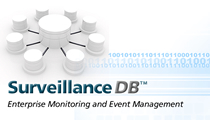Essential monitoring tools deliver real-time performance views, issue identification and resolution, proactive alerting, data collection & reporting
 |
 |
||||||||
 |
|||||||||
 |
 |
 |
|||||||
The Surveillance toolset is made up of 4 major components. Click on a specific function above for more details.
Surveillance includes an comprehensive set of standard features. Listed are a few below:
- Heterogeneous Database Support
- Single View of Entire System Enterprise
- Threshold-Based Trending Analysis
- Powerful Flexibility and Extensibility Options
- Interpret Log Files
- Flexible Enterprise Deployment
- Root Cause Determination
- Proactive intervention Business Trending Analysis
- Reporting Across Multiple Platforms and Systems
Heterogeneous Database Support
Surveillance DB™ supports Sybase, Oracle, MS SQL Server, DB2 UDB and MySQL environments in one product, making it your single, integrated source to enable DBAs monitor and maintain a single relational database environment or an enterprise of hundreds of disparate servers and databases — providing a single view for all your entire database environment.
As databases proliferate within an IT organization, demand for around-the-clock surveillance increases. A single tool that can manage the databases and scale to grow with the environment becomes even more important. Distributed environments demands proactive management that detects and resolves problems automatically wherever possible. However, avoiding problems alone is not enough. With Surveillance as the command center, DBAs can spend more time on day-today operations and less time on problem solving.
Single View of Entire System Enterprise
Surveillance provides a single view of the entire system topology. The graphical user interface consists of comprehensive, real time views of database activity with the ability to drill-down for root cause analysis and cause determination giving users the ability to determine what is affecting performance and availability.
Threshold-based Alarms and Alerts
Set up multiple thresholds (and the accompanying alarms and alerts) across differing database, OS and network environments and platforms. Reporting across multiple platforms and systems Surveillance enables users to run reports across multiple platforms and systems. The reports can be scheduled to run automatically – i.e. trending and capacity planning reports.
Powerful flexible & extensible options
Extend the functionality of Surveillance by incorporating existing scripts and/or building customized data collections. Existing pre-written monitoring scripts can be imported and incorporated into the Surveillance framework. Once they are imported or created, they become part of the overall product functionality with alarm, alert and report capability.
Interpret Log Files
Monitor any application through its log files and to alert on application errors and warnings, or any other messages.
Flexible Enterprise or Standalone Deployment
Designed with enterprise deployments in mind, Surveillance can also be used as a standalone solution or as an easily and efficiently complement to any existing framework or Surveillance Client service. Surveillance may also be integrated with a variety of third party products for help desk, report generation, alarms and event management or general central services.
Root Cause Determination
Drill down into over 2,500 different performance statistics to pinpoint the actual cause of an outage. Surveillance Flashback™ allows users to turn back time and view the user interface to see statistics as if they were occurring right now to determine what caused the performance change. Proactive intervention Business trending analysis.
Proactive intervention Business trending analysis
As an example, business executives might want to be notified when the number of orders or transactions being processed each hour falls below a certain number. Surveillance Event Management can alert by email or text message (SMS) when the hourly rate of processed orders falls below a defined threshold.
Reporting across multiple platforms and systems
The Reporting Module enables users to run reports across multiple platforms and systems. The reports can be scheduled to run automatically – i.e. trending and capacity planning reports. There are three major components to this module: the local host-based repository, the centralized repository, and the reporting system. With either added solution, customers can create their own report specifications and use the predefined Surveillance report specifications.


